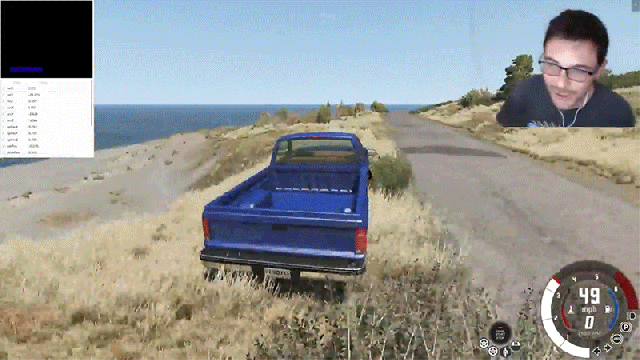If you’re a fan of racing sims, a steering wheel controller is a must-have accessory, but it’s also a slippery slope towards spending thousands of dollars on a motion simulator for the ‘full experience.’ YouTube’s Mean Gene Hacks spent just $US50 ($64) on their simulator that translates an in-game vehicle’s motions to a player, but it does so using some creepy electrical stimulation of nerves that help maintain a human’s balance.
Your typical driving simulator usually features a racing-style seat with a steering wheel, pedals, shifters, and a bunch of giant screens filling a driver’s view, all perched atop a platform connected to pneumatic pistons that move the cockpit around in 3D space to more or less match the motion’s of an on-screen vehicle. It can add a convincing level of realism to a racing game or simulator as the player feels the simulated forces of being in a real car, but all that hardware means these rigs are often priced well north of $US50,000 ($64,000). But what if the human body could be convinced to recreate all those moves on its own without the pricy hardware?
It turns out a process called galvanic vestibular stimulation — also known as GVS — can be used to alter a human’s sense of balance by electrically stimulating a nerve in the ear using electrodes. Researchers haven’t quite figured out the best uses of the technology — medical, military, and entertainment companies are all investigating it — but when used properly it can convince a person that they need to move their bodies to the left or right to maintain balance, which the body will automatically do all on its own, even if they’re standing perfectly still. As a result there’s a peculiar side effect of GVS: the technology can be used to partially control a human’s movements as if they were being operated remotely.
That’s exactly what Mean Gene Hacks is doing here. Using about $US50 ($64) worth of external hardware (plus the cost of a gaming PC) they’ve made BeamNG.drive, a highly realistic physics-based driving simulator — interface with GVS hardware. Custom code translates an in-game vehicle’s motions into the electrical signals that alter a player’s balance, which are delivered to a player’s nerve endings through a pair of adhesive electrodes that attach to the neck just behind the earlobes. The resulting effect has the player uncontrollably leaning to the left or to the right while playing, as if effected by the same G-forces the car in the game is experiencing.
It’s no where near the same driving experience as you’d get in a simulator, the hacked together alternative doesn’t really translate forward and back motions to the player when a vehicle is accelerating or braking in the game, but the lateral side to side motions, when a vehicle is tearing around a corner at high speeds, are very much felt, and maybe even too much so. As Mean Gene Hacks points out, as their body repeatedly leans from side to side, the effects of the galvanic vestibular stimulation actually make driving in the game very difficult, as a human’s sense of balance governs so much of how they move.
Because galvanic vestibular stimulation isn’t in wide use yet it’s not entirely known how safe it is or isn’t, but preliminary studies seem to indicate that so far there have been no unwanted side effects observed in patients using the technology to assist with stroke recovery. It will, however, be a while before we see companies like Nintendo releasing ‘fun’ GVS accessories for their consoles. If the Wii’s heart-rate monitoring Vitality sensor was deemed too controversial to ever see the light of day, what chance does a technology that manipulates human balance have?
